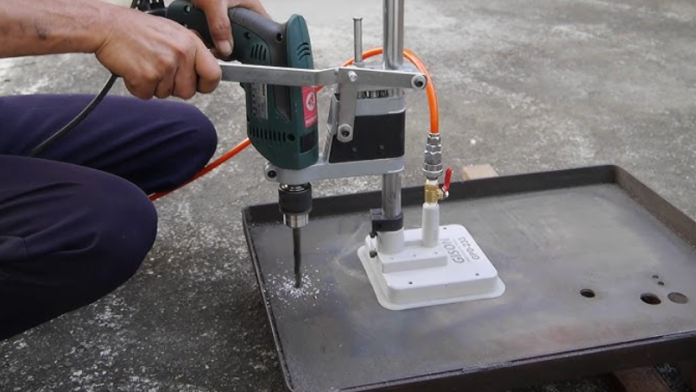Knowing how to measure vacuum suction is essential when selecting the right suction cup for your industrial or automation needs. Proper suction measurement ensures that your lifting system delivers optimal grip, stability, and efficiency, especially in applications where precision and safety are critical. In this article, we’ll walk you through the key steps and factors involved in accurately measuring vacuum suction and load requirements.
Understanding Vacuum Suction
Vacuum suction uses negative pressure (lower than the surrounding air) to hold, lift, or move objects. It creates a pressure difference in which the higher outside air pressure pushes the object toward the lower-pressure area, producing suction.
Devices such as vacuum pumps, ejectors, or blowers create this low-pressure zone by removing air from a sealed space, like a suction cup or vacuum chamber.
The strength of the suction depends on two main factors:
- Vacuum level – The greater the pressure difference, the stronger the holding force.
- Flow rate – Determines how quickly air is removed and how well suction is maintained, especially if there are small leaks.
Accurate measurement and control of suction are essential.
- Too little suction can cause the object to slip or fall.
- Too much suction can waste energy or damage delicate items.
By carefully monitoring vacuum levels, systems can achieve safe, efficient, and reliable handling in industrial and everyday applications.
Fundamental Physics: Understanding Vacuum Suction Force
Vacuum suction force is the holding or lifting power created when the air pressure inside a suction cup is lower than the surrounding atmospheric pressure. When air is removed from the cup, the higher outside air pressure pushes the cup against the object’s surface, creating a secure grip.
The suction cup works because atmospheric pressure pushes the object into the low-pressure area, not by pulling it. This is what allows vacuum systems to hold objects firmly without mechanical clamps.
The suction force can be calculated using the formula:
F=P×AF = P \times AF=P×A
Where:
- F = Suction (holding) force in Newtons (N)
- P = Pressure difference between atmospheric pressure and the vacuum inside the cup in Pascals (Pa)
- A = Contact area of the suction cup in square meters (m²)
This shows that the suction force increases if either the pressure difference or the contact area grows.
Why It Matters
Calculating suction force accurately is critical for safety and efficiency. Too little force can cause objects to slip or fall, while too much force can damage delicate materials or waste energy. Understanding these principles ensures vacuum systems work reliably, safely, and efficiently in real-world applications.
Working Principle: How Vacuum Suction Works
Vacuum suction works by using differences in air pressure to create a holding or lifting force, allowing objects to be handled securely without clamps or mechanical gripping. Here’s a simple breakdown of how it works:
- Contact and Seal
The suction cup is placed on the object’s surface, forming a tight seal that prevents air from entering. A tight seal is essential, as even small leaks can reduce vacuum strength and cause slipping.
- Air Evacuation
Air is removed from inside the suction cup using a vacuum pump, ejector, or generator. This lowers the internal pressure below atmospheric pressure.
- Pressure Difference Creation
The difference between the low pressure inside the cup and the higher external air pressure generates a net force that pushes the cup and object together. The outside air “pushes” the object; the vacuum does not pull it.
- Holding Force Established
When a stable pressure difference is achieved, the suction cup creates a strong grip on the object. This holding force keeps the object securely in place, allowing it to be lifted, moved, or rotated safely.
Supporting Forces
- Gravity: Atmospheric pressure caused by gravity provides the main “push” that holds the object against the cup.
- Friction: Friction between the cup and object adds stability. Smooth surfaces rely mostly on the seal, while rough or oily surfaces increase friction but may reduce sealing efficiency.
Vacuum suction works by using differences in air pressure to create a strong, stable grip on an object. This makes them essential for industrial automation, packaging, and precision manufacturing.
See also: Philadelphiabased Gpsdenied 35m Series Reliance 107msinghtechcrunch
Steps to Measure Vacuum Suction
Step 1: Prepare the System
Ensure the vacuum source (pump or ejector) is clean and functioning properly. Check all hoses, fittings, and valves for any leaks to ensure the system can maintain a stable vacuum.
Step 2: Connect the Vacuum Gauge or Sensor
Attach the vacuum gauge or sensor as close to the suction cup as possible to ensure accurate measurement of the vacuum pressure. Make sure all fittings are correct and airtight to prevent leaks, which could give false readings or reduce suction efficiency.
Step 3: Activate the Vacuum System
Turn on the vacuum pump or ejector and let the system run until it reaches a stable vacuum level. This ensures consistent suction for accurate measurements and safe operation.
Step 4: Record the Vacuum Level
Measure and record the vacuum level with the suction cup empty (no-load) to see the maximum vacuum your system can reach. Compare these measurements with the vacuum level recommended for the suction cup to ensure it is performing correctly and safely.
Step 5: Verify Holding Force
Determine the holding force by using the measured vacuum level and the suction cup’s contact area. Ensure the calculated force safely supports the object’s weight and surface type.
Factors That Affect Vacuum Suction Measurement
Several factors influence how accurately vacuum suction can be measured and how effectively it performs in real applications:
- Workpiece Surface Characteristics
The surface of the object plays a major role. Smooth, flat, and nonporous surfaces allow better sealing and stronger suction. Rough, uneven, or porous materials (like wood or cardboard) cause air leakage, reducing vacuum strength. The presence of oil, dust, or residue can also weaken the seal.
- Effective Suction Area and Geometry
The size and shape of the suction cup determine the area where pressure acts. A larger contact area creates a greater holding force. Cup geometry (flat, bellows, or curved) should match the shape of the workpiece for an effective seal and accurate suction measurement.
- Vacuum Level (Pressure Difference, Δp)
The suction force depends directly on the pressure difference between the ambient air and the vacuum inside the cup. A higher pressure difference means a stronger holding force. Ambient conditions like altitude or temperature can also influence this pressure differential.
- Friction and Orientation
When lifting vertically, friction between the suction cup and the workpiece helps resist sliding. The direction of lift (horizontal or vertical) affects how gravity interacts with the vacuum force, impacting the required safety margin.
- Environmental and Operational Conditions
Temperature, humidity, and contamination can affect suction efficiency. External factors like vibration, wind, or movement can cause vacuum loss or leaks during operation.
- System Leakage and Air Supply
Leaks in hoses, fittings, or seals reduce actual vacuum levels. The vacuum pump or ejector must provide enough airflow to maintain pressure even when minor leaks occur. Poor maintenance or long, narrow piping can also lower performance.
Accurate vacuum suction relies on factors such as surface condition, suction cup design, vacuum level, friction, environment, and system integrity. Managing these ensures safe, stable, and efficient handling in real applications.



